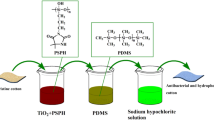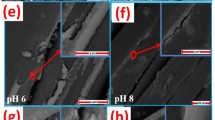Abstract
In this research, a one-step method for the preparation of superhydrophobic and antibacterial cotton fabric is presented, which has been modified by zinc oxide (ZnO) nanoparticles and octadecanethiol (ODT). The individual use of ZnO and ODT resulted in superhydrophilic fabrics whereas their combined use caused a transformation to the superhydrophobic behavior. Based on the morphological analysis, the distribution of ZnO nanoparticles on the fabrics’ surfaces was notably improved leading to a much more uniform rough structure. Such proper level of roughness along with the hydrophobicity induced by ODT were found responsible for the observed high contact angle (161°). The deposition of ZnO and ODT on the fabrics’ surfaces was further proved by X-ray photoelectron spectroscopy. The bacterial adhesion experiments revealed that even the sole presence of ODT could notably reduce the bacterial attachment to the fabric due to the reduced surface free energy. The individual use of ZnO nanoparticles was found to have a strong antibacterial effect on both Staphylococcus aureus (Gram-positive) and Escherichia coli (Gram-negative) bacteria. The bacterial adhesion was even further diminished upon the combined use of ZnO and ODT. The numbers of adhered S. aureus and E. coli cells were highly reduced from 438,000 and 192,000 CFU cm−2 for the pristine fabric to 600 and 48 CFU cm−2 for the superhydrophobic fabric, respectively. Simultaneous achievement of superhydrophobicity and antibacterial activity on the fabrics’ surfaces could have promising potential in the hospital garments and facemasks where patients and staff need to be protected from the infections.







Similar content being viewed by others
References
Bolvardi B, Seyfi J, Hejazi I, Otadi M, Khonakdar HA, Drechsler A, Holzschuh M (2017) Assessment of morphology, topography and chemical composition of water-repellent films based on polystyrene/titanium dioxide nanocomposites. Appl Surf Sci 396:616–624
Brayner R, Ferrari-Iliou R, Brivois N, Djediat S, Benedetti MF, Fievet F (2006) Toxicological impact studies based on Escherichia coli bacteria in ultrafine ZnO nanoparticles colloidal medium. Nano Lett 6:866–870
Bruzaud J, Tarrade J, Celia E, Darmanin T, Taffin de Givenchy E, Guittard F, Herry JM, Guilbaud M, Bellon-Fontaine MN (2017) The design of superhydrophobic stainless steel surfaces by controlling nanostructures: a key parameter to reduce the implantation of pathogenic bacteria. Mater Sci Eng C 73:40–47
Cassie ABD, Baxter S (1944) Wettability of porous surfaces. Trans Faraday Soc 40:546–550
Crick CR, Ismail S, Pratten J, Parkin IP (2011) An investigation into bacterial attachment to an elastomeric superhydrophobic surface prepared via aerosol assisted deposition. Thin Solid Films 519:3722–3727
Esmaeilpour M, Niroumand B, Monshi A, Ramezanzadeh B, Salahi E (2016) The role of surface energy reducing agent in the formation of self-induced nanoscale surface features and wetting behavior of polyurethane coatings. Prog Org Coat 90:317–323
Fadeeva E, Truong VK, Stiesch M, Chichkov BN, Crawford RJ, Wang J, Ivanova EP (2011) Bacterial retention on superhydrophobic titanium surfaces fabricated by femtosecond laser ablation. Langmuir 27:3012–3019
Freschauf LR, McLane J, Sharma H, Khine M (2012) Shrink-induced superhydrophobic and antibacterial surfaces in consumer plastics. PLoS ONE 7:40987
Fürstner R, Barthlott W, Neinhuis C, Walzel P (2005) Wetting and self-cleaning properties of artificial superhydrophobic surfaces. Langmuir 21:956–961
Han JT, Kim S, Karim A (2007) UVO-tunable superhydrophobic to superhydrophilic wetting transition on biomimetic nanostructured surfaces. Langmuir 23:2608–2614
Hejazi I, Seyfi J, Sadeghi GMM, Jafari SH, Khonakdar HA, Drechsler A, Davachi SM (2017) Investigating the interrelationship of superhydrophobicity with surface morphology, topography and chemical composition in spray-coated polyurethane/silica nanocomposites. Polymer 128:108–118
Hsieh CT, Chen WY, Wu FL (2008) Fabrication and superhydrophobicity of fluorinated carbon fabrics with micro/nanoscaled two-tier roughness. Carbon 46:1218–1224
Ivanova NA, Philipchenko AB (2012) Superhydrophobic chitosan-based coatings for textile processing. Appl Surf Sci 263:783–787
Karimi L, Yazdanshenas ME, Khajavi R, Rashidi A, Mirjalili M (2014) Using graphene/TiO2 nanocomposite as a new route for preparation of electroconductive, self-cleaning, antibacterial and antifungal cotton fabric without toxicity. Cellulose 21:3813–3827
Padmavathy N, Vijayaraghavan R (2008) Enhanced bioactivity of ZnO nanoparticles—an antimicrobial study. Sci Technol Adv Mater 9:035004
Piltan S, Seyfi J, Hejazi I, Davachi SM, Khonakdar HA (2016) Superhydrophobic filter paper via an improved phase separation process for oil/water separation: study on surface morphology, composition and wettability. Cellulose 23:3913–3924
Poortinga AT, Bos R, Norde W, Busscher HJ (2002) Electric double layer interactions in bacterial adhesion to surfaces. Surf Sci Rep 47:1–32
Qian H, Li M, Li Z, Lou Y, Huang L, Zhang D, Xu D, Du C, Lu L, Gao J (2017) Mussel-inspired superhydrophobic surfaces with enhanced corrosion resistance and dual-action antibacterial properties. Mater Sci Eng C 80:566–577
Raghupathi KR, Koodali RT, Manna AC (2011) Size-dependent bacterial growth inhibition and mechanism of antibacterial activity of zinc oxide nanoparticles. Langmuir 27:4020–4028
Rosi NL, Mirkin CA (2005) Nanostructures in biodiagnostics. Chem Rev 105:1547–1562
Salehabadi S, Seyfi J, Hejazi I, Davachi SM, Naeini AH, Khakbaz M (2017) Nanosilica-decorated sponges for efficient oil/water separation: role of nanoparticle’s type and concentration. J Mater Sci 52:7017–7027
Seyfi J, Hejazi I, Jafari SH, Khonakdar HA, Sadeghi GMM, Calvimontes A, Simon F (2015) On the combined use of nanoparticles and a propersolvent/non-solvent system in preparation of superhydrophobic polymer coatings. Polymer 56:358–367
Seyfi J, Hejazi I, Jafari SH, Khonakdar HA, Simon F (2016) Enhanced hydrophobicity of polyurethane via non-solvent induced surface aggregation of silica nanoparticles. J Colloid Interface Sci 478:117–126
Stallard CP, McDonnell KA, Onayemi OD, O’Gara JP, Dowling DP (2012) Evaluation of protein adsorption on atmosphere plasma deposited coatings exhibiting superhydrophilic to superhydrophobic properties. Biointerphases 7:31
Suryaprabha T, Sethuraman MG (2017) Fabrication of copper-based superhydrophobic self-cleaning antibacterial coating over cotton fabric. Cellulose 24:395–407
Verho T, Bower C, Andrew P, Franssila S, Ikkala O, Ras RHA (2011) Mechanically durable superhydrophobic surfaces. Adv Mater 23:673–678
Wang J, Han F, Zhang S (2016) Durably superhydrophobic textile based on fly ash coating for oil/water separation and selective oil removal from water. Sep Purif Technol 164:138–145
Wenzel RN (1936) Resistance of solid surfaces to wetting by water. Ind Eng Chem 28:988–994
Xiang T, Ding S, Li C, Zheng S, Hu W, Wang J, Liu P (2017) Effect of current density on wettability and corrosion resistance of superhydrophobic nickel coating deposited on low carbon steel. Mater Des 114:65–72
Xing S, Jiang J, Pan T (2013) Interfacial microfluidic transport on micropatterned superhydrophobic textile. Lab Chip 13:1937–1947
Xu B, Cai ZS (2008) Fabrication of a superhydrophobic ZnO nanorod array film on cotton fabrics via a wet chemical route and hydrophobic modification. Appl Surf Sci 254:5899–5904
Yan H, Zhou H, Ye Q, Wang X, Cho CM, Yan A, Tan X, Xu J (2016) Engineering polydimethylsiloxane with two-dimensional graphene oxide for an extremely durable superhydrophobic fabric coating. RSC Adv 6:66834–66840
Yang W, Li J, Zhou P, Zhu L, Tang H (2017) Superhydrophobic copper coating: switchable wettability, on-demand oil-water separation, and antifouling. Chem Eng J 327:849–854
Zhang X, Wang L, Levänen E (2013) Superhydrophobic surfaces for the reduction of bacterial adhesion. RSC Adv 3:12003–12020
Zhao Y, Tang Y, Wang X, Lin T (2010) Superhydrophobic cotton fabric fabricated by electrostatic assembly of silica nanoparticles and its remarkable buoyancy. Appl Surf Sci 256:6736–6742
Zhu C, Shi J, Xu S, Ishimori M, Sui J, Morikawa H (2017) Design and characterization of self-cleaning cotton fabrics exploiting zinc oxide nanoparticle-triggered photocatalytic degradation. Cellulose 24:2657–2667
Acknowledgments
Partial financial support from the Iranian Nanotechnology Initiative is gratefully appreciated.
Author information
Authors and Affiliations
Corresponding author
Ethics declarations
Conflict of interest
The authors declare that they have no conflict of interest.
Electronic supplementary material
Below is the link to the electronic supplementary material.
Rights and permissions
About this article
Cite this article
Ghasemi, N., Seyfi, J. & Asadollahzadeh, M.J. Imparting superhydrophobic and antibacterial properties onto the cotton fabrics: synergistic effect of zinc oxide nanoparticles and octadecanethiol. Cellulose 25, 4211–4222 (2018). https://doi.org/10.1007/s10570-018-1837-9
Received:
Accepted:
Published:
Issue Date:
DOI: https://doi.org/10.1007/s10570-018-1837-9




